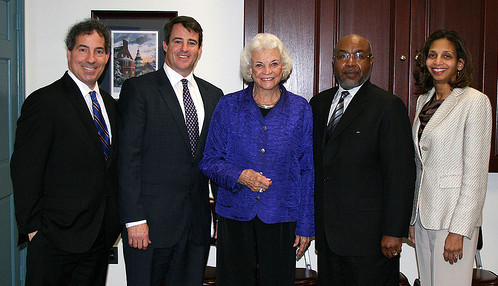Hello, readers. There are no Fourth Amendment decisions being handed down (I just want my warrant rights clarified, Court!) and we’ve still got a week to go before the same-sex marriage cases, so I’m going to take a break from present-day Supreme Court happenings to discuss a problem found at the Court, in the American political system, and across all levels of American society: work-life balance and gender inequality in the workplace.
In light of the recent debate between Anne-Marie Slaughter, a dean at Princeton and former Department of State official, and Sheryl Sandberg, COO of Facebook, “women in the workplace” have suddenly been catapulted into the public sphere. Should women be forced to choose between a high-powered career and their family, as Slaughter argues in her famous Atlantic article, or should they “lean in” to the workplace and juggle careers and motherhood, as Sandberg’s new book proposes? This fight is not new and has in fact been going on since the time of Gloria Steinem and Betty Friedan. The ideological schism reaches deep into the core of womanhood in America, where children are still socialized, in the twenty-first century, to associate women with the home and men with leadership positions. As Georgia Duerst-Lahti points out in the book Gender and Elections, edited by Susan Carroll and Richard Fox, the presidency is a “gendered space,” and children learn from a young age to associate men with political power. For example, she explains, when children are asked to draw an apple, they draw the red fruit, not the computer or iPhone. When children are asked to draw a president, they draw a man. The most basic connotation of the word “president” is, for these children, “man.”
And this isn’t just the case with the presidency—in 2013, women hold 18.1% of the seats in Congress combined (20 out of 100 seats in the Senate, 77 out of 435 seats in the House), are 5 out of the 50 governors, and make up 24.1% of all state legislatures (according to the Center for American Women in Politics). For group that constitutes literally half of America’s population (50.8% in 2010), women are deeply underrepresented in the world of United States politics, and much of that underrepresentation stems from the difficulty in balancing work and home life.
What, exactly, does this gender disparity have to do with the Supreme Court? There are three women currently serving, one of whom is also a racial minority, and this is certainly a result of the strides made by Justices Sandra Day O’Connor and Ruth Bader Ginsburg. However, O’Connor and Ginsburg both had to strike a balance between their familial and career-related ambitions, whereas their male counterparts did not need to do so. Sandra Day O’Connor gave birth to three boys between 1957 and 1962, after she graduated from law school, and instead of choosing between her career and her children, she worked her hardest to raise them while also opening a law firm (from here). As the first woman to serve on the Court, O’Connor also faced discrimination: she once received a letter addressed to “Mrs. John O’Connor” that called her role as Supreme Court Justice inappropriate for “a wife and mother who respects the psychological components of a family” (from here). For Ginsburg, “motherhood was held out as the reason” that she should not have attended law school (as she explained in an interview), yet this duality between her roles as mother and law student led her to believe that her “life was more balanced.” She was “less apprehensive than [her] classmates because there was something going on that was more important, frankly, than the law.” Ginsburg viewed the combination of motherhood and career-building as rewarding; on the other side of the argument, Justice Sotomayor chose a career over child-rearing, citing ambition as one of the many reasons she and ex-husband Kevin Noonan decided not to have children (from Good Morning America). Finally, Justice Kagan is unmarried and has no children, yet has had a tremendously successful career. The Court is just a microcosm of the wider debate, but it demonstrates both sides of the issue: women like O’Connor and Ginsburg decided to be mothers but still held high-powered jobs, as Sandberg argues, but other women like Sotomayor and Kagan felt it necessary to choose between the two spheres, as Slaughter advocates.
The male justices of the Court are also married, and many of them have children, but as men, they did not have to bear the major responsibility of child-rearing while they pursued their judicial careers. As Jennifer Lawless and Richard Fox argue in their book It Still Takes a Candidate, women must put in full hours at work and then come home to another full-time job: raising their children, cooking dinner, and doing other housework. Their partners might help them, and may even take a large share of the household management duties, but for the most part, American culture has socialized both women and men to expect that the women will run the house while the men go work in high-level positions. How can women be expected to make themselves more of a force in the American political system, whether as judges or elected officials or members of the bureaucracy, when we are also expected to “work a second full-time job” at home? This is heart of the Slaughter-Sandberg debate: what are women supposed to do? If you’re ambitious and don’t want a family, you’re heartless and cold. If you would rather stay at home and care for your children, you’re undermining feminism. It’s a no-win situation, and it’s a serious problem. For politically-minded women across the United States, this “work versus home” conundrum is a stressor and something that lessens political participation. As both Sandberg and Slaughter explain, conventional wisdom about gender equity in the workplace—and in the home—must change.
